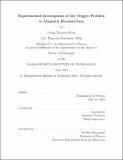| dc.contributor.advisor | Jan Egedal. | en_US |
| dc.contributor.author | Katz, Noam Karasov | en_US |
| dc.contributor.other | Massachusetts Institute of Technology. Dept. of Physics. | en_US |
| dc.date.accessioned | 2011-05-09T13:59:06Z | |
| dc.date.available | 2011-05-09T13:59:06Z | |
| dc.date.copyright | 2010 | en_US |
| dc.date.issued | 2010 | en_US |
| dc.identifier.uri | http://hdl.handle.net/1721.1/62601 | |
| dc.description | Thesis (Ph. D.)--Massachusetts Institute of Technology, Dept. of Physics, 2010. | en_US |
| dc.description | This electronic version was submitted by the student author. The certified thesis is available in the Institute Archives and Special Collections. | en_US |
| dc.description | Cataloged from student-submitted PDF version of thesis. | en_US |
| dc.description | Includes bibliographical references (p. 145-154). | en_US |
| dc.description.abstract | Magnetic reconnection is a fundamental process in plasma physics, which involves the often explosive release of magnetically stored energy in both space and laboratory plasmas. In order for this sudden release of energy to occur, there must be a period of slow reconnection, in which magnetic stress accumulates in the system, followed by a quick transition to fast reconnection. The question of what causes this transition is known as the 'trigger problem' and is not well understood. We address the trigger problem using the Versatile Toroidal Facility (VTF) at MIT, which we operate in the strong magnetic guide field regime. The resulting reconnection occurs in spontaneous events, in which there is a transition to fast reconnection. The reconnection in these events is asymmetric: it begins at one toroidal location and propagates toroidally in both directions. The spontaneous onset is facilitated by an interaction between the x-line current channel and a global mode, which breaks axisymmetry. We model the onset using an empirical Ohm's law and current continuity, which is maintained by ion polarization currents associated with the mode. The model reproduces the exponential growth of the reconnection electric field, and the model growth rate agrees well with the experimentally measured growth rate. We begin, however, by discussing reconnection in the collisional regime and the effect of neutral gas on plasma flows. We perform experiments which are relevant to plasmas at the edge of tokamaks, but may also be applicable to reconnection in the solar photosphere and the interstellar medium, where the ionization fraction is low. In these experiments, a plasma filament propagates across a magnetic field in a background of neutral atoms. The filament motion is driven by charge separation in an inhomogeneous magnetic field, and this drive is balanced by collisional damping. The filament propagation and internal structure are described in detail. | en_US |
| dc.description.statementofresponsibility | by Noam Karasov Katz. | en_US |
| dc.format.extent | 154 p. | en_US |
| dc.language.iso | eng | en_US |
| dc.publisher | Massachusetts Institute of Technology | en_US |
| dc.rights | M.I.T. theses are protected by
copyright. They may be viewed from this source for any purpose, but
reproduction or distribution in any format is prohibited without written
permission. See provided URL for inquiries about permission. | en_US |
| dc.rights.uri | http://dspace.mit.edu/handle/1721.1/7582 | en_US |
| dc.subject | Physics. | en_US |
| dc.title | Experimental investigation of the trigger problem in magnetic reconnection | en_US |
| dc.type | Thesis | en_US |
| dc.description.degree | Ph.D. | en_US |
| dc.contributor.department | Massachusetts Institute of Technology. Department of Physics | |
| dc.identifier.oclc | 713599895 | en_US |
